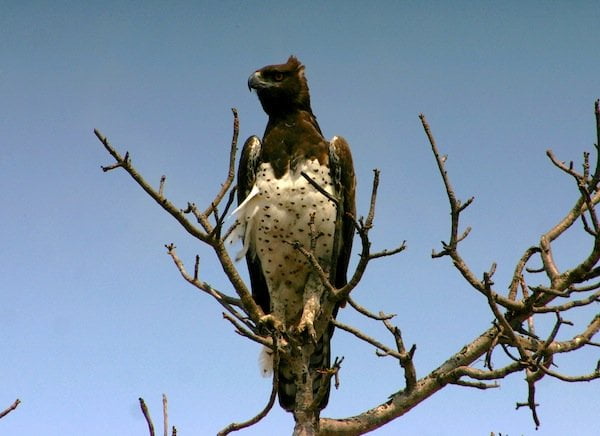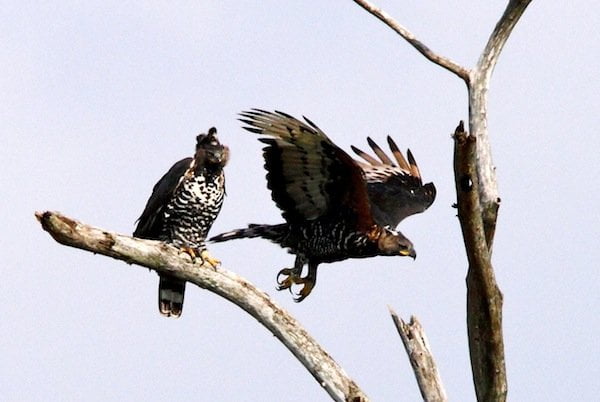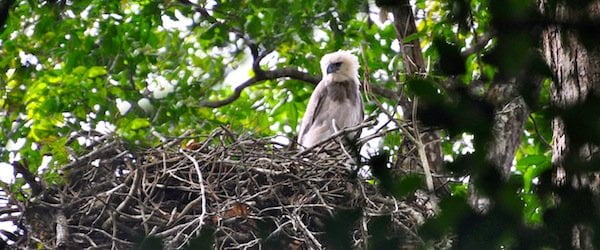Having grown up in Africa, I regard myself as extremely fortunate to have spent most of my life in close proximity to some of the world’s most spectacular large eagles. As a boy I remember watching spellbound as an adult Verreaux’s Eagle (then called Black Eagle ) snatched a Rock Hyrax twenty feet from me on the slopes of Table Mountain. I have witnessed the raw power of a Martial Eagle, one of the world’s heaviest eagles, take down a young Nyala antelope. And I have marveled at a pair of Crowned Eagles successfully catching Vervet Monkeys in the northeast corner of South Africa.
 Martial Eagle by David Shackelford
Martial Eagle by David Shackelford
 A pair of Crowned Eagles by Adam Riley
A pair of Crowned Eagles by Adam Riley
But from as early as I can remember it is the Harpy Eagle that has been at the top of my “most wanted’ list. My dream of seeing this magical bird was fulfilled, albeit much too belatedly, during a 2008 BATV film trip to Guyana. Whilst researching this trip, I spent some time thinking about what makes the Harpy Eagle such a sought-after species. After all, there are many enigmatic species that birders long to see so what makes this particular bird so special? After picking the brains of some of the world’s top birders I realized that there is no one reason for this bird’s allure. In most cases the rarity of a particular species is the sole reason for its enigma. But the rarity of Harpy Eagles is only one of a handful of reasons why any warm-blooded birder drools at the mere mention of its name.
 Harpy Eagle at nest by David Shackelford
Harpy Eagle at nest by David Shackelford
Consider the fact that it is a contender for the title of largest eagle in the world, although there may be a few Steller’s Sea Eagles, Martial Eagles and Philippine Eagles who would give it a good run for its money. Consider for a moment the power that is required to pluck adult Howler Monkeys and sloths from the rainforest canopy. Or consider the fact that it is a stunningly beautiful animal. The coloration is subtle but definitive and every aspect of its physical make-up points to a creature that has reached the pinnacle of evolutionary perfection. Finally, consider the fact that even it’s nomenclature speaks volumes about the bird’s presence and personality. The name “Harpy” comes from the Greek word harpazein which means “to snatch”. Harpy Eagles are named after the harpies of ancient mythology who were part-human, part-raptor personifications of the destructive elements of wind. In his work Inferno XIII, Dante describes harpies as follows:
Here the repellent harpies make their nests,
Who drove the Trojans from the Strophades
With dire announcements of the coming woe.
They have broad wings, a human neck and face,
Clawed feet and swollen, feathered bellies: they caw
Their lamentations in the eerie trees.
The other name for the Harpy Eagle – “The Flying Wolf” – needs little explanation. On a recent trip to Belize, we caught up with Sharon Matola from the Belize Zoo and she introduced us to a wonderful male Harpy Eagle, an ambassador for his species.
httpvh://www.youtube.com/watch?v=rj4GJtuYIdU
And so back to Guyana in 2008…It was with great anticipation as I headed out from the small village of Surama deep in the heart of Guyana with my crew and a few local guides to try and get a glimpse of this mythical creature. The best chances of seeing Harpy Eagles is undoubtably at known nest sites in countries like Brazil, Guyana or Suriname. But we were taking a bit of a chance with the Surama nest as the chick was already free-flying and about a year old. My worst fears were realized on the first day when we hiked over a mile into the forest only to find an empty nest and not a Harpy in sight. But we did find a lone feather, an indication of the presence of at least one bird.
On our last day in the area we gave it a final go and headed off, drenched in sweat, and accompanied by the piercing calls of Screaming Pihas, a sound which I will forever associate with Harpy Eagles. And there it was – a juvenile Harpy Eagle sitting high up in a kapok tree. We had lucked out because the bird did not fly off. It was too pre-occupied with the remains of a kill that either it, or more likely one of its parents, had dispatched earlier in the day. This ranks right up there with some of my best birding moments and, although I’ve seen Harpy Eagles since, seeing this bird was truly unforgettable. The moment was captured for posterity in our Harpy Eagle show.













How fortunate you are to have grown up near some of the most impressive birds in the world and to have seen Harpies- it is such a mega bird! The first good looks I had at them were a pair building a nest in Tambopata, Peru. They were so huge and their bills and talons so massive, that I recall feeling instinctively intimidated and a bit anxious. Although being referred to as “The Flying Wolf” reflects their power and cunning, I think “Avian Tiger” might be a more accurate monniker because they are a top predator that hunts solo and by stealth. Thanks for doing a show on this neotropical monster!
kool
Great bird. I need to get down to South America.
What an impressive bird…! Sharon and James are braver than I am. (This Harpy Eagle post by Julie Zickefoose made my hair stand on end.)
Like Vermfly, I really need to get down to South America. [“It’s like America, but south.”]
Absolutely gorgeous raptors and a thrill to see anytime, anywhere!
I cannot see a photo of a crowned eagle without hearing them call in my head – wonderful. and I have always wanted to see a Harpy, narrowly missing them on numerous occasions in Costa Rica…
@Dale. I will always remember my life Crowned Eagle at Wilderness. We spotted what we thought was a very distant Forest Buzzard being harassed by a songbird and then – raising our binoculars – found out the “songbird” was indeed a Forest Buzzard.
Classic Jochen. I always remember hearing Crowned Eagles in the sandforests of KwaZulu and then finding out that they were actually Red-capped Robin-chats (Natal Robins) mimicking them from the understory. Frustrating little buggers!
James, please be so kind to NOT mention Natal Robins. I searched for them in vain in the Caprivi Strip and this bird was the one miss that hurt the most. 😉
@ Jochen, great story. Crowneds are awesome and Forest Buzzards are never a dry ID challenge!
@ James, how did I know someone was going to say that. Natal Robins – the masters of the fake Crowned Eagle call.
@ Jochen (again), natal robins are normally dead easy to find on the KwaZulu-Natal coast. Just listen for the Crowned Eagle that turns in to a Fierynecked Nightjar, that turns in to a telephone, that turns in to a sombre bulbul…